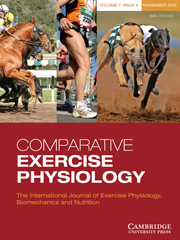Article contents
Potassium-free electrolytes and calcium supplementation in an endurance race
Published online by Cambridge University Press: 01 February 2008
Abstract
Some of the clinical signs seen in horses during endurance races may result from increases in neuromuscular excitability and are related to plasma [K+] and [Ca++]. The present study aimed to test the following hypotheses: (1) Potassium supplementation will affect plasma [K+] and may result in clinical signs related to neuromuscular hyperexcitability during an 80 km endurance ride. (2) Plasma [Ca++] will reflect dietary cation–anion balance (DCAB) and calcium intake. Feeding with a high DCAB and high dietary calcium content (1.5% total calcium of daily ration) diets would lead to higher plasma [Ca++] during an endurance race than on feeding high DCAB diets with a moderate dietary calcium content (1% of total calcium of daily ration). The current study was undertaken during the 80 km endurance research ride in 2002 in Virginia, USA. Forty volunteer rider–horse pairs participated in the race. During the race, electrolyte mixtures with (EM+K) and without (EM − K) potassium were supplied to 18 and 22 horses, respectively. After the race, the horses receiving EM − K during the race were supplied with a recovery formula containing potassium (EM-REC). The horses were fed in addition to their own forage (hay and pasture) either their own commercial concentrate (CC; 1% calcium, n = 11) or one of two research-supplied concentrates during 3 months preceding the research ride, one concentrate rich in sugar and starch (SS; 2% calcium, n = 15) and the other rich in fat and fibre (FF; 2% calcium, n = 14). Peripheral blood samples were taken the day before, within 3 min of the arrival at the vet checks at 27, 48 and 80 km, and after 3 h of recovery. Plasma samples were analysed for pH, haematocrit (Hct), [Na+], [K+], [Cl− ], [Ca++], [Mg++], total protein (TP) and albumin [alb]. Effects of sampling times, treatments and interactions were evaluated by ANOVA in a mixed model with repeated measures and applied to the 25 horses that completed 80 km. Eliminated horses had their blood sampled before entering the elimination vet check and 3 h after elimination, and were compared with finishing horses by t-test. As the ride progressed, significant increases were found in plasma pH, [Na+],  , [TP], [alb], Hct and osmolality; and decreases in [K+], [Mg++], PCO2, [Ca++] and [Cl− ]. Horses supplied with potassium-free, sodium-rich electrolyte formulae (EM − K) had 12.5% lower (P = 0.001) mean plasma [K+], 7.8% lower (P = 0.024) TP and 8.4% lower (P = 0.004) albumin at 80 km, and at 3 h after the race they had 6.8% lower (P = 0.045) TP, when compared with EM+K supplemented horses. Horses fed with SS and FF had higher [Ca++] at 27 (P = 0.027), 56 (P = 0.006) and 80 km (P = 0.022) when compared with horses fed with CC. The lower [K+] in the EM − K group, and the higher [Ca++] in the SS- and FF-supplemented horses may help prevent increases in neuromuscular excitability and related clinical signs. The lower TP and albumin indicate less dehydration in the EM − K group and could help prevent related disorders.
, [TP], [alb], Hct and osmolality; and decreases in [K+], [Mg++], PCO2, [Ca++] and [Cl− ]. Horses supplied with potassium-free, sodium-rich electrolyte formulae (EM − K) had 12.5% lower (P = 0.001) mean plasma [K+], 7.8% lower (P = 0.024) TP and 8.4% lower (P = 0.004) albumin at 80 km, and at 3 h after the race they had 6.8% lower (P = 0.045) TP, when compared with EM+K supplemented horses. Horses fed with SS and FF had higher [Ca++] at 27 (P = 0.027), 56 (P = 0.006) and 80 km (P = 0.022) when compared with horses fed with CC. The lower [K+] in the EM − K group, and the higher [Ca++] in the SS- and FF-supplemented horses may help prevent increases in neuromuscular excitability and related clinical signs. The lower TP and albumin indicate less dehydration in the EM − K group and could help prevent related disorders.
Information
- Type
- Research Paper
- Information
- Copyright
- Copyright © Cambridge University Press 2008
References
- 2
- Cited by

